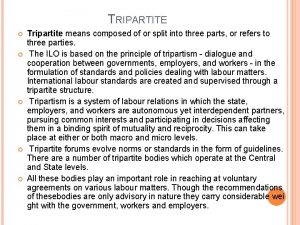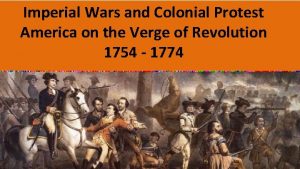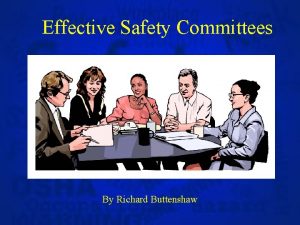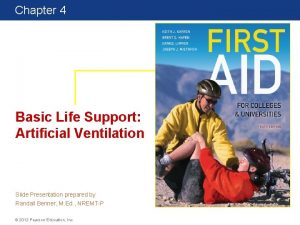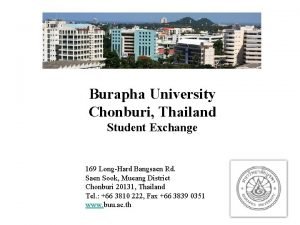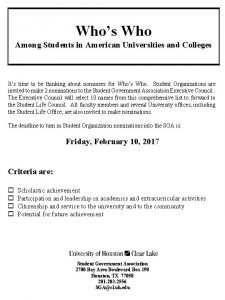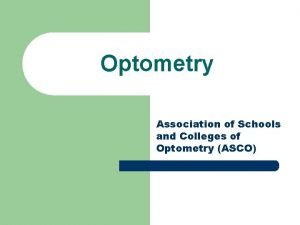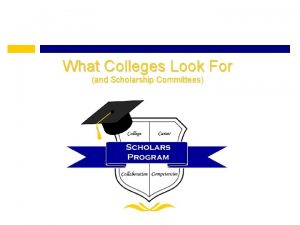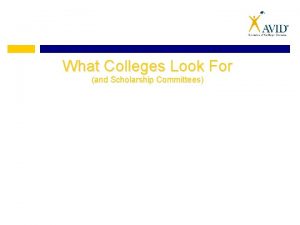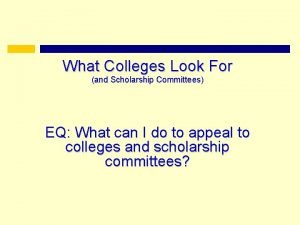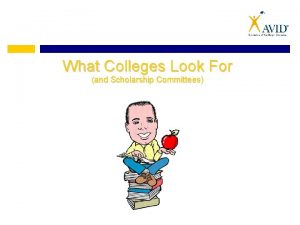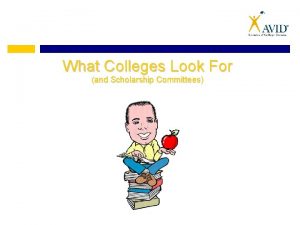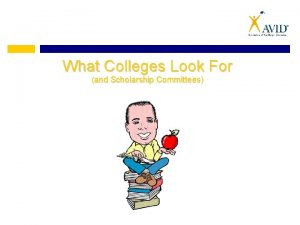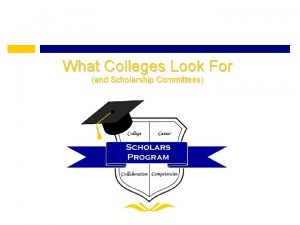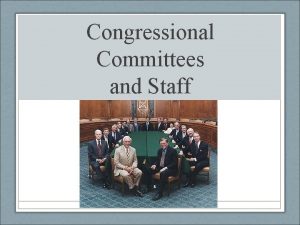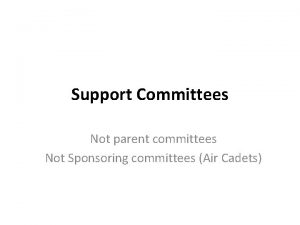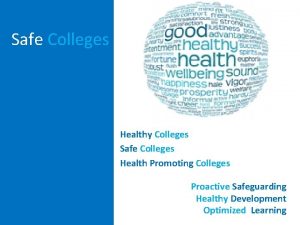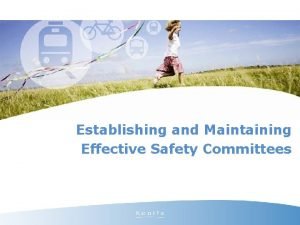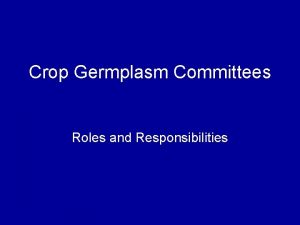What Colleges Look For and Scholarship Committees Colleges






















- Slides: 22

What Colleges Look For (and Scholarship Committees)

Colleges are Looking for the “Total Package” 1. G. P. A. and Class Rank 2. Test Scores 3. Challenging Classes 4. Letters of Recommendation 5. Personal Insight Questions or College Admissions Essay 6. Extra Curricular Involvement 7. Work Experiences 8. Other Factors

1. G. P. A. and Class Rank • • • Your grade point average (G. P. A. ) is the average of all the classes you take during high school. At one time, this made up 40% of the points for the UC application process. Your class rank is how you compare to other students in your class. The higher your G. P. A. , the higher your rank. Aim to be in the top 10% of your class. • If you are in a class of 170, you should be one of 17 students with the highest G. P. A.

1. Test Scores (ACT/SAT) • • ACTs and SATs are taken during junior and senior year of high school. Tests may be taken more than once so you can submit the highest score to the college. The average ACT score in California in 2020 was 23. 3 out of 36. The average SAT score in California in 2020 was 1065 out of 1600.

1. Test Scores (continued) • • Most colleges accept ACT or SAT scores. You will do better on one test, so take both and choose the higher score to submit to the college. You can have low test scores, but a high G. P. A. or a low G. P. A. , but a high SAT/ACT score and still get into college. At one time, this made up 30% of the points for the UC application process.

UC Application Data Fall 2018 of Middle 25%-75% of students Campus Admit Rate G. P. A ACT Composite Scores SAT Reading & Writing Scores SAT Math Scores SAT Essay Scores Berkely 14. 9% 4. 16 – 4. 30 30 - 35 660 - 750 680 - 790 16 - 20 Davis 41. 2% 3. 97 – 4. 25 26 - 33 600 - 700 620 - 780 15 - 18 Irvine 28. 8% 4. 00 – 4. 26 26 - 33 600 - 710 630 - 780 15 - 18 Los Angeles 14. 1% 4. 16 – 4. 31 31 - 35 670 - 750 690 - 790 16 - 20 Merced 66. 9% 3. 46 – 3. 96 19 - 27 510 - 630 510 - 650 13 - 17 Riverside 50. 9% 3. 66 – 4. 09 22 - 30 570 - 670 560 - 710 14 - 17 San Diego 30. 2% 4. 07 – 4. 28 29 - 34 640 - 730 660 - 790 16 - 18 Santa Barbara 32. 3% 4. 00 – 4. 26 28 - 34 630 - 720 640 - 780 15 - 18 Santa Cruz 47. 7% 3. 76 – 4. 16 26 - 32 590 - 700 620 -750 14 - 18 Source: http: //admission. universityofcalifornia. edu/freshman/profiles/index. html

Cal State Application Data Fall 2017 Campus Admit Rate Average G. P. A. Average SAT Score (Math & Reading) Average ACT Score Bakersfield 93% 3. 2 905 19 Channel Islands 74% 3. 22 925 20 Chico 65% 3. 33 1000 21 Dominguez Hills 58% 3. 13 851 17 East Bay 74% 3. 1 901 19 Fresno 52% 3. 33 900 19 Fullerton 42% 3. 56 997 22 Humboldt 75% 3. 26 992 22 Long Beach 36% 3. 5 1033 22 Los Angeles 64% 3. 18 880 17 Maritime Academy 85% 3. 3 Monterey Bay 49% 3. 32 977 20 Source: CSU Campus Profiles, Admissions

Cal State Application Data Fall 2017 Continued Campus Admit Rate Average G. P. A. Average SAT Score (Math & Reading) Average ACT Score Northridge 45% 3. 2 920 19 Pomona 39% 3. 49 1062 24 Sacramento 67% 3. 3 949 20 San Bernardino 65% 3. 21 893 San Diego 34% 3. 69 1113 25 San Francisco 68% 3. 23 997 21 San Jose 68% 3. 4 1040 23 San Luis Obispo 31% 3. 92 1239 28 San Marcos 85% 3. 19 Sonoma 55% 3. 2 Stanislaus 67% 3. 36 938 19 Source: CSU Campus Profiles, Admissions

3. Challenging Classes • Taking challenging classes shows the admissions officer that you are ready for college. – Examples: College Prep, A. P. , Honors, College Classes • • • If you can earn a “B” in a challenging class, it is better than an “A” in an easy class. Colleges have a list of the challenging classes you can take at your high school. If you don’t take challenging classes, it could hurt your chances of getting into college.

A-G Requirements

4. Letters of Recommendation • • Usually required for private colleges or universities Not usually required for public universities

5. College Admissions Essay/ Personal Insight Questions • • The writing assignment helps show the college your uniqueness Required by UCs Typically required by private colleges Not required by Cal States

Personal Insight Questions (for University of California) 1. Describe an example of your leadership experience in which you have positively influenced others, helped resolve disputes, or contributed to group efforts over time. (350 Word Maximum) 2. Every person has a creative side, and it can be expressed in many ways: problem solving, original and innovative thinking, and artistically, to name a few. Describe how you express your creative side. (350 Word Maximum) 3. What would you say is your greatest talent or skill? How have you developed and demonstrated that talent over time? (350 Word Maximum) 4. Describe how you have taken advantage of a significant educational opportunity or worked to overcome an educational barrier you have faced. (350 Word Maximum)

Personal Insight Questions (for University of California) 5. Describe the most significant challenge you have faced and the steps you have taken to overcome this challenge. How has this challenge affected your academic achievement? (350 Word Maximum) 6. Think about an academic subject that inspires you. Describe how you have furthered this interest inside and/or outside of the classroom. (350 Word Maximum) 7. What have you done to make your school or your community a better place? (350 Word Maximum) 8. Beyond what has already been shared in your application, what do you believe makes you stand out as a strong candidate for admissions to the University of California? (350 Word Maximum)

6. Extra Curricular Involvement/Community Service • • UC’s look for 200+ hours of community service. Shows your have good time management Makes you appear “well-rounded” and not just about good grades Colleges want to see leadership skills – Don’t just join a bunch of clubs/activities/sports – Choose clubs/activities/sports where you can be a leader (president, team captain, etc. )

7. Work Experience • • Part-time work Internships (paid or unpaid) Start your own business (babysitting, lawn mowing, etc. ) Working demonstrates maturity, initiative, work ethic, as well as interpersonal and time management skills

8. Other Factors • • Geographical Diversity – students from places other than communities surrounding the school Legacy – parents or grandparents attend the same college Ethnic Heritage – your race/ethnicity is need to make college more diverse Socio-Economic Background – more financial aid to less fortunate students

8. Other Factors (Continued) • • • First in Family to Attend College Ability to Overcome Adversity – death, single parent home, difficult personal or family situation, major illness, etc. Senior Year – challenging classes and number of classes

Apply to all 3 Types of Schools 1. ) Safety Schools: Colleges where your academic qualifications are above the average accepted student. 2. ) Match Schools: Colleges where your academic qualifications match the average accepted student. 3. ) Reach Schools: Colleges where your academic qualifications are below the average accepted student. Even if your grades and SAT/ACT scores aren’t the greatest, colleges want a diverse student population. Maybe your community service, sports, special talents, accomplishments, race/ethnicity, skills, special circumstances, etc. are what your reach school needs to appear to be diverse. They might need you!

Don’t Let Averages Keep You From Applying to Reach Schools Let’s pretend that you have a 3. 1 G. P. A. Last year’s incoming college freshmen had an average G. P. A. of 3. 86. Should you apply to this reach school? YES! Let’s pretend that this college is only accepting 5 students next year (to make this illustration easy). Look at the chart below. The average G. P. A. is 3. 8. Next Year’s Incoming Freshmen G. P. A. Jeff Smith 3. 1 Maria Sanchez 4. 2 Jose Rodriguez 3. 9 Tanisha Brown 4. 1 Aliyah Ahmed 4. 0 Average G. P. A. of Applicants 3. 8 You are Jeff Smith! Welcome to your reach school!

Get IGETC stands for Intersegmental General Education Transfer Curriculum. It is a general education pattern which community college transfer students can use to fulfill lower-division general education requirements in either the CSU or UC system without the need, after transfer, to take additional lower-division general education requirements. Focus on these transferrable units instead of focusing on getting an A. A. or A. S. degree from your local community college. An A. A. or A. S. degree means nothing once you get a B. A. or B. S.

Undergraduate Degree Graduate Degree Types of College Degrees Type of College: 4 Year College or University Degrees Available: Doctoral Degree (i. e. Ph. D, Ed. D) Average Completion Rate for Degree: Degree 6 -8 years Type of College: 4 Year College or University Degrees Available: Master of Arts (M. A. ) or Master of Science (M. S. ) Average Completion Rate for Degree: Degree 1 -2 years Type of College: 4 Year College or University Degrees Available: Bachelor of Arts (B. A. ) or Bachelor of Science (B. S. ) Average Completion Rate for Degree: Degree 4 -6 years Type of College: Community College, Junior College Degrees Available: Associate of Arts or Science (A. A. or A. S. ) Average Completion Rate for Degree: Degree 2 -3 years
 Look to the left look to the right
Look to the left look to the right Compare the functions of joint and conference committees.
Compare the functions of joint and conference committees. Ilc and slc
Ilc and slc Committees of correspondence
Committees of correspondence Examples of select committees
Examples of select committees Lesson 4 congressional committees answer key
Lesson 4 congressional committees answer key Committees of correspondence
Committees of correspondence Health work committees
Health work committees Rotary intercountry committees
Rotary intercountry committees Effective safety committees
Effective safety committees Effective safety committees
Effective safety committees Look at the picture in activity 3
Look at the picture in activity 3 By looking at the picture from your first activity
By looking at the picture from your first activity 1 look at the picture
1 look at the picture World federation of colleges and polytechnics
World federation of colleges and polytechnics First aid for colleges and universities
First aid for colleges and universities Fh
Fh Ufa state petroleum technological university
Ufa state petroleum technological university Chelyabinsk colleges and universities
Chelyabinsk colleges and universities Chon buri colleges and universities
Chon buri colleges and universities Yaroslavl colleges and universities
Yaroslavl colleges and universities Who's who in american colleges and universities
Who's who in american colleges and universities Association of schools and colleges of optometry
Association of schools and colleges of optometry


